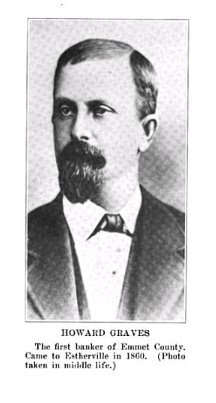116 EMMET AND DICKINSON COUNTIES
was established under the name of Emmet, with George C. Granger as
the first postmaster. Mr. Granger was also the first merchant in the
county. Jesse Coverdale served as second lieutenant of Company A,
Northern Border Brigade, at the time of the Civil war, and was afterward
elected one of the county board of supervisors, in which capacity
he served for one term of three years.
The Minneapolis & St. Louis Railroad runs through the southeastern
portion, but there is no station within the township limits. Estherville,
which is only one mile from the southern boundary, and Huntington, in
the northwest comer of Ellsworth Township, are the most convenient
trading and shipping points.
There are five public schools in the township and during the school
year of 1915-16 six teachers were employed. The population in 1910
was 375 and in 1915 the property was assessed for taxation at $284,120.
ESTHERVILLE TOWNSHIP.
This is the middle township of the western tier and includes Congres‐
sional Township 99, Range 34. Its area is therefore thirty-six square
miles and it is bounded as follows: On the north by Emmet Township;
on the east by Center; on the south by Twelve Mile Lake, and on the
west by Dickinson County. The west fork of the Des Moines River crosses
the northern boundary near the northwest corner of Section 2 and from
that point it flows almost south for a distance of two miles, when it turns
more to the southeast and crosses the eastern boundary about two miles
north of the southeast corner. Along the west side of the river are the
largest hills in the county. East of the Des Moines the surface is a
rolling plain, which is also the character of the surface in the western
portion, near the Dickinson County line. On the western border, in
Section 18, is a small body of water called Four Mile Lake. Its outlet
falls into the Des Moines at Estherville.
Estherville was one of the first civil townships to be established in
Emmet County, and takes its name from the county seat, which is situated
within its limits. As in the case of all the early townships, the
records relating to the erection and organization of Estherville were
destroyed by the burning of the court-house in October, 1876, and the
exact date of its establishment cannot be ascertained.
Among the first settlers in this township were Robert E. Ridley and
his wife, A. H. Ridley, and the Graves family, the former coming from
the State of Maine in the spring of 1857, and the Graves family from
Winneshiek County, Iowa, a little later. Robert E. Ridley, the pioneer
settler of the township, is still living in Estherville. Most of the history
of this township centers about the county seat and is told in connection
with the City of Estherville in another chapter.
